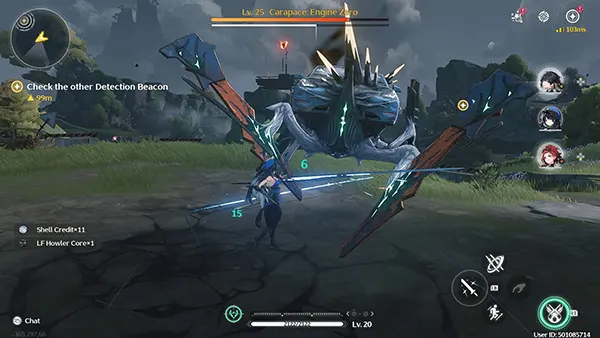
Wuthering Waves: Survival and Levelling Guide for 2025
The success of “Wuthering Waves” in early 2025 confirms its status as a breakthrough RPG that combines fast-paced combat, open-world exploration, and strategic character progression. Set in a post-apocalyptic world enriched with mysterious energy known as “Sonance,” players must navigate through harsh terrains, develop their characters efficiently, and survive dynamic threats that evolve with the storyline. To progress effectively, players must grasp the core mechanics of survival and optimise their levelling approach.
Understanding the Survival System in Wuthering Waves
Survival in “Wuthering Waves” is more than avoiding enemy damage—players must monitor environmental hazards, manage resources, and adapt to varying biomes. Key regions like the Rusted Highlands or the Blooming Abyss present different threats, from toxic flora to unstable magnetic storms. These threats can drastically affect stamina recovery, combat abilities, and movement efficiency.
To counteract these elements, equipping elemental-resistant gear and crafting consumables like Radiant Elixirs or Stormward Rations is crucial. These items mitigate environmental damage and boost regeneration. Players can acquire blueprints for such gear by completing exploration missions and regional events scattered across the map.
The survival system also includes dynamic weather cycles and day-night shifts that influence enemy aggression and spawn rates. For example, Phantom Beasts are more active at night, requiring players to either prepare accordingly or avoid certain areas after dark.
Tips for Long-Term Survival Efficiency
Investing in base camp upgrades can significantly improve sustainability. Establishing camps near teleportation points and resource-rich zones ensures quick recovery and access to essential materials. Each camp can be upgraded to provide crafting stations, storage, and healing zones.
Maintaining inventory efficiency is equally vital. Hoarding unessential loot slows down traversal and limits mobility during critical encounters. Players should periodically recycle or convert old gear into upgrade materials through the “Echo Conversion” station available in major settlements.
Finally, interacting with factions such as the Sentinel Order or Echo Seekers provides access to unique survival technologies and recipes. Building reputation with these groups unlocks advanced defensive structures and rare consumables that give players a critical edge in harsher regions.
Optimising Character Levelling and Progression
Character levelling in “Wuthering Waves” hinges on synergy between gear, ability upgrades, and resonance compatibility. Each character aligns with a specific resonance type—Solar, Lunar, Terra, or Nova—which impacts their elemental abilities and interaction with the environment and foes.
To level effectively, players should prioritise main and faction storylines, as these grant high-value XP and materials. Side missions and ambient challenges, while useful, often yield lower returns relative to the time investment. Balancing core missions with daily bounties ensures consistent growth.
Levelling also requires investment in Memory Imprints—modular enhancements that fine-tune a character’s stats. Imprints are unlocked through Echo Realms, procedurally generated dungeons that scale with the player’s power level, offering replayability and scalable rewards.
Crafting the Perfect Levelling Loadout
Players should build around weapon synergy and resonance amplification. For instance, Terra-type characters benefit from heavy, earth-affiliated weapons that stagger enemies and generate shields. Weapons like the “Crag Reaper” or “Stone Lattice Blade” enhance crowd control and sustainability in prolonged fights.
Skill sequencing matters greatly. Efficient levelling demands optimised combo chains that reduce cooldown times and trigger passive resonance effects. Players can unlock and equip alternate skill branches via the Conflux Shrine, adding diversity to combat and levelling options.
Equipping characters with resonance harmonisers—accessories that boost specific elemental abilities—also speeds up progression. Crafting or purchasing them from faction vendors offers a significant power spike, especially during elite enemy encounters or boss phases.

Resource Management and Upgrade Priorities
Resource scarcity is a recurring challenge, especially in mid to late-game zones. Players must smartly allocate materials like Lumite Shards, Chrono Dust, and Synth Resin. These are used for crafting gear, unlocking Echo Realms, and upgrading abilities or camp structures.
Prioritising weapon enhancement over armour upgrades often yields better results in early stages. A strong offensive setup helps players dispatch threats faster, reducing damage intake and resource consumption. Armour becomes more relevant when enemies start using resonance break mechanics or elemental counters.
Investing in a stable income source, such as bounty loops or faction trading tasks, provides a steady supply of essential upgrade materials. Weekly faction contracts and biome-specific relic hunts are especially efficient in acquiring high-tier crafting items.
Efficient Use of the Game’s Economy
The game’s internal economy uses multiple currencies: Echo Coins, Guild Tokens, and Aeon Credits. Echo Coins are general-purpose, while Guild Tokens grant access to exclusive weaponry, and Aeon Credits are mainly used in the multiplayer raid economy. Managing this balance is key for timely upgrades.
Marketplace trading allows players to exchange rare materials and Resonance Stones with others. Participating in this system requires careful market observation—certain items spike in value during limited-time events or patch updates, enabling smart trading for profit.
Finally, never neglect synthesising duplicates. Duplicate gear and imprints can be broken down into Refined Echo Dust, which is a core ingredient in late-stage crafting. This dust also contributes to faction prestige, unlocking additional perks and alliance-specific weapons.
